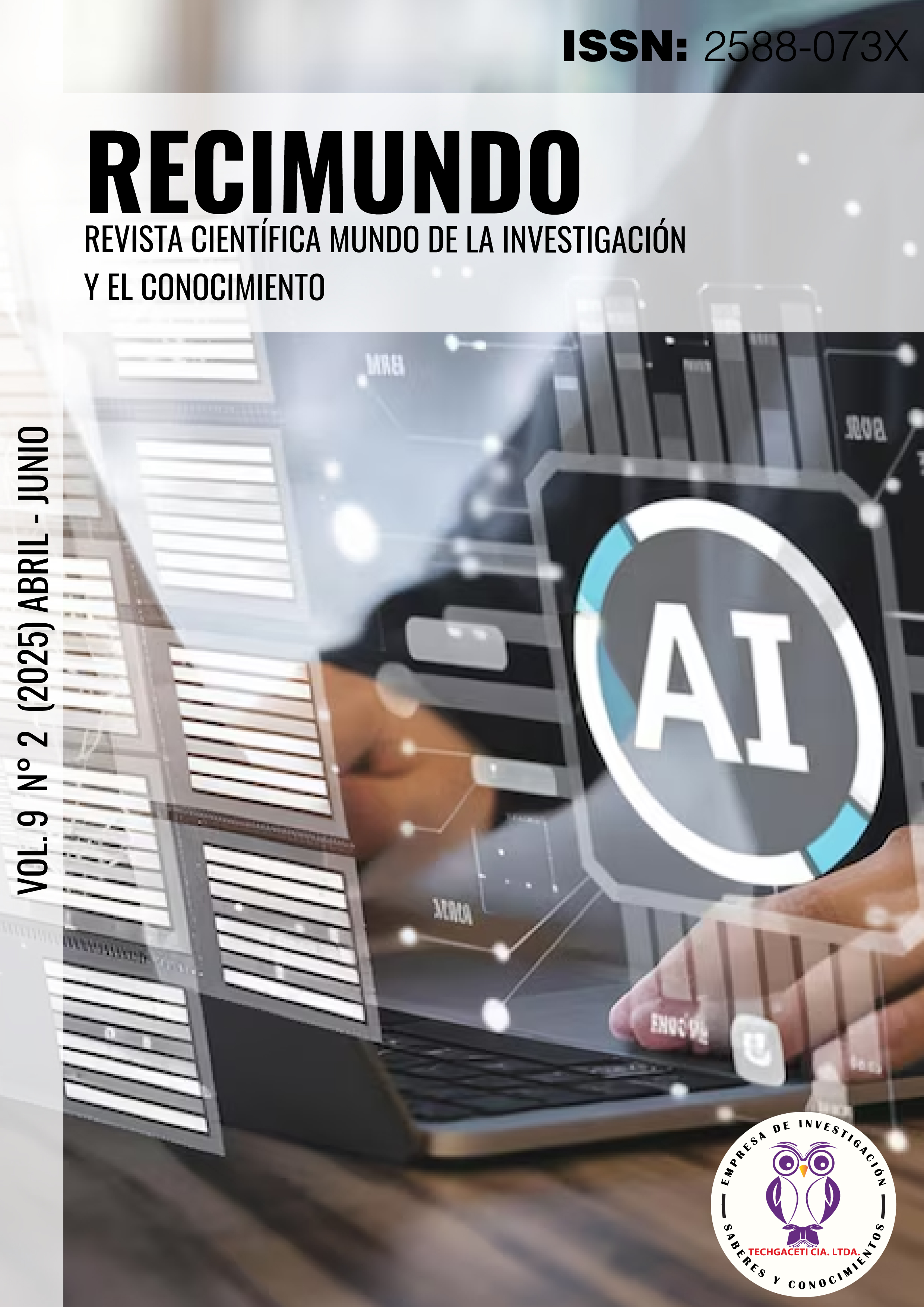Use of indocyanine green (ICG) fluorescence in laparoscopic surgery: benefits in anatomical identification and prevention of biliary injuries. A systematic review
DOI:
https://doi.org/10.26820/recimundo/9.(2).abril.2025.710-723Palabras clave:
Laparoscopic surgery, Laparoscopy, Indocyanine green, ICG, Fluorescence, Fluorescent imagingResumen
The objective of this study is to discuss the use of indocyanine green (ICG) fluorescence in laparoscopic surgery, as well as its benefits in anatomical identification and the prevention of biliary injuries. We delve deeply into topics related to laparoscopy and the risk of biliary injuries, factors predisposing to the development of biliary lithiasis, the Amsterdam classification describing bile leaks and strictures, the use of ICG fluorescence in laparoscopic surgery, and an introduction to ICG technology. Regarding the methodological guidelines, this study was characterized as a PRISMA-type systematic review. Inclusion and exclusion criteria were applied, along with keywords in both English and Spanish, to construct search strings for databases such as Google Scholar, SciELO, and Elsevier. Finally, it was concluded that the administration of indocyanine green (ICG) fluorescence in laparoscopic surgery is highly useful. It is an efficient method that aids in the precise, real-time visualization of anatomical structures of the biliary ducts, the cystic duct, and blood vessels, thereby reducing the probability of accidental injuries to the biliary tree and other surrounding tissues. Within the surgical process, it allows the surgeon to perform dissection precisely, avoiding iatrogenic injuries due to the clear identification of anatomical structures, which prevents complications during surgery.Descargas
Citas
López PADC, Velásquez FS. USO TRANSOPERATORIO DE FLUORESCENCIA CON VERDE DE INDOCIANINA COMO MÉTODO DE PREVENCIÓN DE LAS LESIONES IATROGÉNICAS DE LA VÍA BILIAR [Internet]. UNIVERSIDAD DE SAN CARLOS DE GUATEMALA; 2022. Available from: https://biblioteca.medicina.usac.edu.gt/tesis/pre/2022/040.pdf
Pérez GAB, Maica JMR, Flores YDJM, Roz CRF, Riveros EVH, Bello AAG. Fluorescencia con verde de indocianina intravesicular en colecistectomía laparoscópica. Rev Digit Postgrado. 2024;13(3).
Farfán Feijoo AP, Bowen Flores EC, Cedeño Intriago MD, Cedeño Sabando TD, Loor Mera JA, Quijije Menéndez JB, et al. Cirugía laparoscópica: teoría y ciencia [Internet]. Primera. Mawil Publicaciones de Ecuador, 2021; 2021. Available from: https://mawil.us/cirugia-laparoscopica-teoria-y-ciencia/
Venegas Quenta JA. Factores asociados a complicaciones post colecistectomía laparoscópica en pacientes con patología biliar en el Servicio de cirugía general del Hospital Hipólito Unanue de Tacna, enero a diciembre del 2019 [Internet]. Universidad Nacional Jorge Basadre Grohman; 2020. Available from: https://repositorio.unjbg.edu.pe/server/api/core/bitstreams/41bd2f9b-d960-4a03-9483-4497e763b7eb/content
Torres Maldonado XE, Urgiles Rivas MV, Vélez Peralta CA. PATOLOGIA BILIAR. Tesla Rev Científica [Internet]. 2022 Jul 1; Available from: https://tesla.puertomaderoeditorial.com.ar/index.php/tesla/article/view/74
Cervantes JG, Quiñonez EG, Chahdi Beltrame M, Poupard M, Lenz Virreira ME, Mattera FJ. Lesión quirúrgica de vía biliar compleja. Manejo conservador. Rev Argent Cir [Internet]. 2022 [cited 2025 Jun 29];114(2):177–80. Available from: https://www.scielo.org.ar/scielo.php?script=sci_arttext&pid=S2250-639X2022000200177&lng=es&nrm=iso&tlng=es
Rojas AM V, Vera KS. Lesiones de la vía biliar: factores de riesgos, tipo de lesiones relacionados a complicaciones por colecistectomía laparoscópica. J Am Heal. 2024;7(1).
Manterola C, Claros N. Morfología de las Lesiones Iatrogénicas de la Vía Biliar: Aspectos Diagnósticos y Terapéuticos. Int J Morphol [Internet]. 2022 Feb;40(1):210–9. Available from: http://www.scielo.cl/scielo.php?script=sci_arttext&pid=S0717-95022022000100210&lng=en&nrm=iso&tlng=en
Martínez-Mier G, Luna-Ortiz HJ, Hernández-Herrera N, Zilli-Hernandez S, Lajud-Barquin FA. Factores de riesgo asociados a las complicaciones ya la falla terapéutica en las reconstrucciones de lesiones de vía biliar secundarias a colecistectomía. Cir Cir. 2019;86(6):491–8.
Davila MIDLC, Alvarado JC, Corvera CAZ. Estrategias de prevención de lesiones de las vías biliares en la colecistectomía laparoscópica: Una revisión sistemática.: Estrategias de prevención de lesiones de las vías biliares en la colecistectomía laparoscópica. Rev del Cuerpo Médico Hosp Nac Almanzor Aguinaga Asenjo. 2022;1.
Morales-Conde S, Licardie E, Alarcón I, Balla A. Indocyanine green (ICG) fluorescence guide for the use and indications in general surgery: recommendations based on the descriptive review of the literature and the analysis of experience. Cirugía Española (English Ed [Internet]. 2022 Sep;100(9):534–54. Available from: https://linkinghub.elsevier.com/retrieve/pii/S2173507722001934
Peña Cabrera E. La Historia de la Fluorescencia y sus Aplicaciones Modernas en Electrónica y Medicina. Universidad de Guanajuato; 2024.
Garnica X. Colecistectomía laparoscópica de dos incisiones. Estudio experimental. Rev Venez Cirugía [Internet]. 2022 Dec 27;75(2). Available from: https://www.revistavenezolanadecirugia.com/index.php/revista/article/view/475
Haggerty S, Richardson W, Santos B, Fanelli R, Brunt ML, Stefanidis D. Clinical Spotlight Review: Laparoscopic Common Bile Duct Exploration. Soc Am Gastrointest Endosc Surg [Internet]. 2025; Available from: https://www.sages.org/publications/guidelines/clinical-spotlight-review-laparoscopic-common-bile-duct-exploration/
Baladrón González V. Uso del verde de indocianina (limón) en el período perioperatorio de la cirugía hepática: detección de la insuficiencia hepática precoz. [Internet]. Universidad complutense de Madrid; 2018. Available from: https://docta.ucm.es/rest/api/core/bitstreams/b3fa2ec5-78dc-4568-a6ec-8caf6396a7b7/content
Ankersmit M, van Dam DA, van Rijswijk AS, van den Heuvel B, Tuynman JB, Meijerink WJHJ. Fluorescent Imaging With Indocyanine Green During Laparoscopic Cholecystectomy in Patients at Increased Risk of Bile Duct Injury. Surg Innov [Internet]. 2017 Jun 8;24(3):245–52. Available from: https://journals.sagepub.com/doi/10.1177/1553350617690309
Publicado
Cómo citar
Número
Sección
Licencia
Derechos de autor 2025 Adriana Stephania Chancusig Reinoso, Alejandro Solis Vinueza, Julio David Salgado Cedeño, Nelson Francisco Villagómez Albán

Esta obra está bajo una licencia internacional Creative Commons Atribución-NoComercial-CompartirIgual 4.0.



